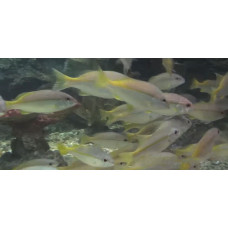Latin name
Lutjanus lutjanus
Other names
Bigeye seaperch, red sea lined snapper, golden striped snapper, rosy snapper, yellow snapper, snapper.
Identification
They have a spindle-shaped. They have a slightly sloping forehead. The front teeth are triangular, and the tongue has a row of granular teeth. The preorbital bone is very narrow, much smaller than the diameter of the eye. The preorbital groove and tubercle are poorly developed. The scale rows on the dorsum are obliquely elevated above the lateral line.
Features of fish fins
The dorsal fin has 10-12 spines and 12 soft rays, while the anal fin has 3 spines and 8 soft rays. The posterior part of the dorsal and anal fins have an angular profile, the pectoral fins have 16-17 rays, and the caudal fin is truncated or weakly pointed.
Fish colouring
The upper back is golden brown with silvery white sides, with a brown to yellow band running from the muzzle to the dorsal tail stalk. The dorsum has oblique golden lines above the lateral line and horizontal stripes below. The dorsal, anal and caudal fins are bright yellow.
Distribution
Widespread in the Indo-West Pacific. Occurs from the Red Sea and East African coast to South Africa and Madagascar, east along the southern coast of Asia, including the Seychelles, to the Pacific Ocean, where it has been recorded from Tonga and Wallis Island. It extends as far north as Japan and as far south as Australia. In Australian waters, it has been recorded from the coast of northwestern Western Australia around the tropical north coast to the north coast of Queensland.
Habitat
These fish can be found at depths of 1 to 96 m (3 feet 3 inches to 315 feet 0 inches) in coral reef areas and coastal waters with soft bottom.
Size
This fish reaches a maximum length of 35 cm (14 inches). Maximum reported age: 11 years.
Behavior
Often found in large aggregations of congeners.
Food and feeding habits
It is a predatory species that hunts fish and crustaceans.
Reproduction
They spawn in the Gulf of Aden in March, off East Africa in November, and in the Gulf of Suez between January and June.
Fishing
In some areas of its range, it is fished with line and bottom trawls and is used as bycatch in shrimp fisheries.
Relationship with a person
The fish has tender, juicy flesh with a pronounced flavor, without a pungent odor or unpleasant fishy tones.
| Classification | |
| Phylum | Chordata |
| Class | Actinopterygii |
| Squad | Perciformes |
| Family | Lutjanidae |
| Genus | Lutjanus |
| Species | L. lutjanus |
| Features | |
| Conservation status | Least Concern |
| Habitat | Pelagic |
| Life span, years | 11 |
| Maximum body weight, kg | No information |
| Maximum length, cm | 35 |
| Sailing speed, m/s | No information |
| Threat to people | Edible |
| Way of eating | Predator |
Bigeye snapper
Tags: bigeye snapper

